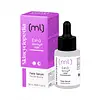What's inside
What's inside
 Key Ingredients
Key Ingredients

 Benefits
Benefits

 Concerns
Concerns

 Ingredients Side-by-side
Ingredients Side-by-side

Water
Skin ConditioningCaprylic/Capric Triglyceride
MaskingGlycerin
HumectantAloe Barbadensis Leaf Juice
Skin ConditioningEthylhexyl Stearate
EmollientIsopropyl Palmitate
EmollientPropanediol
SolventTripelargonin
EmollientBetaine
HumectantSea Water
HumectantPullulan
Simmondsia Chinensis Seed Oil
EmollientGardenia Jasminoides Meristem Cell Culture
AntioxidantHydrolyzed Rhodophyceae Extract
Alpha-Glucan Oligosaccharide
CleansingPolymnia Sonchifolia Root Juice
Skin ConditioningPanax Ginseng Root Extract
EmollientCarnosine
Skin ConditioningCollagen
MoisturisingTocopheryl Acetate
AntioxidantButyrospermum Parkii Butter
Skin ConditioningLeuconostoc/Radish Root Ferment Filtrate
AntimicrobialSerine
MaskingAlanine
MaskingGlycine
BufferingLactobacillus
Skin ConditioningN-Prolyl Palmitoyl Tripeptide-56 Acetate
Skin ConditioningGlutamic Acid
HumectantCeramide Ng
Skin ConditioningCeramide NP
Skin ConditioningCeramide AP
Skin ConditioningCeramide EOP
Skin ConditioningLysine Hcl
Skin ConditioningThreonine
Heptapeptide-7
Skin ConditioningLecithin
EmollientAcetyl Hexapeptide-49
Skin ConditioningPalmitoyl Tripeptide-38
Skin ConditioningArginine
MaskingTetrapeptide-4
Skin ConditioningPalmitoyl Tripeptide-1
Skin ConditioningOligopeptide-68
BleachingAcetyl Heptapeptide-4
HumectantAcetyl Hexapeptide-8
HumectantPalmitoyl Tetrapeptide-7
Skin ConditioningProline
Skin ConditioningPalmitoyl Tripeptide-8
Skin ConditioningPalmitoyl Hexapeptide-12
Skin ConditioningDextran
Phytosphingosine
Skin ConditioningCholesterol
EmollientSodium Lauroyl Lactylate
EmulsifyingLauryl Glucoside
CleansingSodium PCA
HumectantGlycine Soja Oil
EmollientHydrogenated Lecithin
EmulsifyingPentaerythrityl Distearate
EmulsifyingPolyglyceryl-2 Dipolyhydroxystearate
Skin ConditioningPhenoxyethanol
PreservativePentylene Glycol
Skin ConditioningSodium Lactate
BufferingPotassium Cetyl Phosphate
EmulsifyingSodium Carbomer
Emulsion StabilisingHydroxyacetophenone
AntioxidantXanthan Gum
EmulsifyingButylene Glycol
HumectantEthylhexylglycerin
Skin ConditioningDisodium EDTA
Citric Acid
BufferingCarbomer
Emulsion StabilisingHydroxypropyl Cyclodextrin
MaskingMaltodextrin
AbsorbentC12-15 Alkyl Benzoate
AntimicrobialPolysorbate 20
EmulsifyingPCA
HumectantCaprylyl Glycol
EmollientTribehenin
EmollientDipeptide Diaminobutyroyl Benzylamide Diacetate
Skin ConditioningPotassium Sorbate
PreservativeSodium Benzoate
MaskingLactic Acid
BufferingSodium Oleate
CleansingParfum
MaskingCI 17200
Cosmetic ColorantCI 19140
Cosmetic ColorantWater, Caprylic/Capric Triglyceride, Glycerin, Aloe Barbadensis Leaf Juice, Ethylhexyl Stearate, Isopropyl Palmitate, Propanediol, Tripelargonin, Betaine, Sea Water, Pullulan, Simmondsia Chinensis Seed Oil, Gardenia Jasminoides Meristem Cell Culture, Hydrolyzed Rhodophyceae Extract, Alpha-Glucan Oligosaccharide, Polymnia Sonchifolia Root Juice, Panax Ginseng Root Extract, Carnosine, Collagen, Tocopheryl Acetate, Butyrospermum Parkii Butter, Leuconostoc/Radish Root Ferment Filtrate, Serine, Alanine, Glycine, Lactobacillus, N-Prolyl Palmitoyl Tripeptide-56 Acetate, Glutamic Acid, Ceramide Ng, Ceramide NP, Ceramide AP, Ceramide EOP, Lysine Hcl, Threonine, Heptapeptide-7, Lecithin, Acetyl Hexapeptide-49, Palmitoyl Tripeptide-38, Arginine, Tetrapeptide-4, Palmitoyl Tripeptide-1, Oligopeptide-68, Acetyl Heptapeptide-4, Acetyl Hexapeptide-8, Palmitoyl Tetrapeptide-7, Proline, Palmitoyl Tripeptide-8, Palmitoyl Hexapeptide-12, Dextran, Phytosphingosine, Cholesterol, Sodium Lauroyl Lactylate, Lauryl Glucoside, Sodium PCA, Glycine Soja Oil, Hydrogenated Lecithin, Pentaerythrityl Distearate, Polyglyceryl-2 Dipolyhydroxystearate, Phenoxyethanol, Pentylene Glycol, Sodium Lactate, Potassium Cetyl Phosphate, Sodium Carbomer, Hydroxyacetophenone, Xanthan Gum, Butylene Glycol, Ethylhexylglycerin, Disodium EDTA, Citric Acid, Carbomer, Hydroxypropyl Cyclodextrin, Maltodextrin, C12-15 Alkyl Benzoate, Polysorbate 20, PCA, Caprylyl Glycol, Tribehenin, Dipeptide Diaminobutyroyl Benzylamide Diacetate, Potassium Sorbate, Sodium Benzoate, Lactic Acid, Sodium Oleate, Parfum, CI 17200, CI 19140
 Reviews
Reviews

Ingredients Explained
These ingredients are found in both products.
Ingredients higher up in an ingredient list are typically present in a larger amount.
Butylene Glycol (or BG) is used within cosmetic products for a few different reasons:
Overall, Butylene Glycol is a safe and well-rounded ingredient that works well with other ingredients.
Though this ingredient works well with most skin types, some people with sensitive skin may experience a reaction such as allergic rashes, closed comedones, or itchiness.
Learn more about Butylene GlycolCarbomer is a polymer of acrylic acid. Its main role is to create a gel consistency.
A high amount of carbomer can cause pilling or balling up of products. Don't worry, most products contain 1% or less of carbomer.
Glycerin is already naturally found in your skin. It helps moisturize and protect your skin.
A study from 2016 found glycerin to be more effective as a humectant than AHAs and hyaluronic acid.
As a humectant, it helps the skin stay hydrated by pulling moisture to your skin. The low molecular weight of glycerin allows it to pull moisture into the deeper layers of your skin.
Hydrated skin improves your skin barrier; Your skin barrier helps protect against irritants and bacteria.
Glycerin has also been found to have antimicrobial and antiviral properties. Due to these properties, glycerin is often used in wound and burn treatments.
In cosmetics, glycerin is usually derived from plants such as soybean or palm. However, it can also be sourced from animals, such as tallow or animal fat.
This ingredient is organic, colorless, odorless, and non-toxic.
Glycerin is the name for this ingredient in American English. British English uses Glycerol/Glycerine.
Learn more about GlycerinPalmitoyl Tetrapeptide-7 (formerly Palmitoyl Tetrapeptide-3) is a lab-made peptide with anti-inflammatory and skin-repairing benefits. It's made up of four amino acids (glycine, glutamine, proline, and arginine) and palmitic acid (which helps it penetrate skin more effectively).
This ingredient helps reduce inflammation by limiting the production of interleukin-6 (IL-6), a chemical that triggers inflammatory responses, particularly after UV exposure.
Less inflammation = slower collagen breakdown and a longer-lasting, youthful appearance.
Palmitoyl Tetrapeptide-7 also stimulates collagen production and supports a healthier skin barrier.
Over time, this can improve skin firmness, hydration, and reduce the appearance of fine lines. It’s commonly paired with Palmitoyl Tripeptide-1 in the well-known Matrixyl 3000 complex for enhanced anti-aging effects.
This ingredient has been shown to be effective and safe in cosmetic use and you'll typically find it in small amounts (less than 0.01%).
Due to its palmitic acid base, it may not be safe for Malassezia folliculitis.
Read more about other common types of peptides here:
Learn more about Palmitoyl Tetrapeptide-7Palmitoyl Tripeptide-1 is also known as pal-GHK. It is made up of 3 amino acids and palmitic acid, a fatty acid that helps it absorb into skin more easily.
This peptide is as a signal peptide, meaning it tells the skin to produce more collagen. Collagen is the key protein that helps form the skin's structure and keep it plump, firm, and hydrated.
By boosting collagen production, this ingredient supports a stronger skin barrier and helps reduce the appearance of wrinkles.
You'll most likely see this ingredient paired with Palmitoyl Tetrapeptide-7 in the well-known Matrixyl 3000 complex. While results from in-house testing should be viewed cautiously, this peptide duo is among the most studied and widely used in modern skincare.
Due to its palmitic acid base, this ingredient may not be safe for Malassezia folliculitis.
Read more about other common types of peptides here:
Learn more about Palmitoyl Tripeptide-1Phenoxyethanol is a preservative that has germicide, antimicrobial, and aromatic properties. Studies show that phenoxyethanol can prevent microbial growth. By itself, it has a scent that is similar to that of a rose.
It's often used in formulations along with Caprylyl Glycol to preserve the shelf life of products.
Polysorbate 20 is made by combining ethoxylation of sorbitan, ethylene oxide, and lauric acid. It is a mild cleansing agent, surfactant, and emulsifier.
As a surfactant, it helps collect dirt and oils for washing. Emulsifiers prevent oils and water from separating.
Polysorbate 20 also adds scent to a product. Since it is made using sorbitol, it has a sweet scent. Sorbitol can also be found in fruits such as apples and peaches.
The lauric acid used to create Polysorbate 20 is often derived from coconuts.
Polysorbate 20 may not be fungal acne safe.
Learn more about Polysorbate 20Sodium Lactate is the sodium salt of lactic acid, an AHA. It is a humectant and sometimes used to adjust the pH of a product.
This ingredient is part of our skin's NMF, or natural moisturizing factor. Our NMF is essential for the hydration of our top skin layers and plasticity of skin. NMF also influences our skin's natural acid mantle and pH, which protects our skin from harmful bacteria.
High percentages of Sodium Lactate can have an exfoliating effect.
Fun fact: Sodium Lactate is produced from fermented sugar.
Learn more about Sodium LactateWater. It's the most common cosmetic ingredient of all. You'll usually see it at the top of ingredient lists, meaning that it makes up the largest part of the product.
So why is it so popular? Water most often acts as a solvent - this means that it helps dissolve other ingredients into the formulation.
You'll also recognize water as that liquid we all need to stay alive. If you see this, drink a glass of water. Stay hydrated!
Learn more about Water